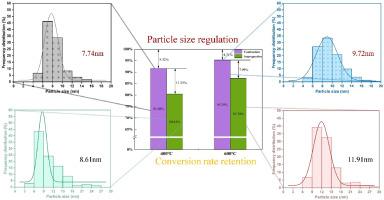Particle size tuning of Ni/CeO2 catalysts and their performance in methane dry reforming reaction
IF 5.5
0 ENERGY & FUELS
引用次数: 0
Abstract
Nickel-based catalysts are prone to sintering and carbon deposition during methane dry reforming (DRM), which limits their industrial application. This study addresses these challenges by designing Ni/CeO2 catalysts with controlled Ni nanoparticle sizes. By varying calcination temperatures, selecting different calcination atmospheres, and comparing preparation methods (equal-volume impregnation vs. combustion method), a series of Ni-based catalysts with different particle sizes were synthesized. The physicochemical properties of the catalysts were elucidated through various characterization techniques. ICP-OES confirmed that the actual Ni loading closely matched the nominal value. XRD and TEM analyses verified that the combustion method yielded smaller NiO nanoparticles with higher dispersion compared to the impregnation method. This advantage stems from the rapid, self-sustaining redox reaction in the combustion process, which effectively inhibits NiO nuclei migration and agglomeration. Consequently, catalysts prepared by the combustion method exhibited superior catalytic activity and stability in DRM. The enhanced performance is directly linked to the smaller Ni particle size, which provides a greater number of active sites and promotes stronger metal-support interactions, thereby improving resistance to sintering and carbon deposition. Furthermore, kinetic studies showed that the smaller Ni nanoparticles were more active, possessing a lower apparent activation energy for methane reforming than the larger particles. These findings provide a clear strategy for the rational design of coke- and sintering-resistant Ni/CeO2 catalysts for carbon-based energy conversion.

Ni/CeO2催化剂的粒径调整及其甲烷干重整反应性能
镍基催化剂在甲烷干重整(DRM)过程中容易烧结和积碳,限制了其工业应用。本研究通过设计具有可控Ni纳米颗粒尺寸的Ni/CeO2催化剂来解决这些挑战。通过改变煅烧温度,选择不同的煅烧气氛,比较等体积浸渍法和燃烧法的制备方法,合成了一系列不同粒径的镍基催化剂。通过各种表征技术对催化剂的理化性质进行了表征。ICP-OES证实,实际Ni负载与标称值非常吻合。XRD和TEM分析证实,与浸渍法相比,燃烧法制备的NiO纳米颗粒体积更小,分散性更高。这一优势源于燃烧过程中快速、自持的氧化还原反应,有效抑制了NiO核的迁移和团聚。因此,燃烧法制备的催化剂在DRM中表现出优异的催化活性和稳定性。性能的增强与更小的Ni粒度直接相关,这提供了更多的活性位点,促进了更强的金属支撑相互作用,从而提高了抗烧结和碳沉积的能力。此外,动力学研究表明,较小的Ni纳米颗粒具有更高的活性,其甲烷重整的表观活化能低于较大的颗粒。这些发现为合理设计用于碳基能量转换的耐焦炭和耐烧结Ni/CeO2催化剂提供了明确的策略。
本文章由计算机程序翻译,如有差异,请以英文原文为准。
求助全文
约1分钟内获得全文
求助全文

 求助内容:
求助内容: 应助结果提醒方式:
应助结果提醒方式:


